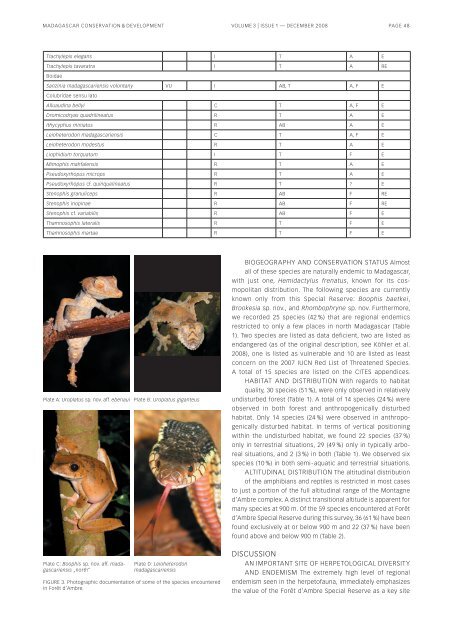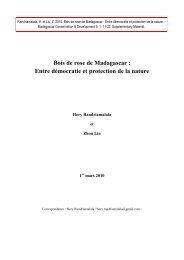Journal Madagascar Conservation - Madagascar Wildlife ...
Journal Madagascar Conservation - Madagascar Wildlife ...
Journal Madagascar Conservation - Madagascar Wildlife ...
You also want an ePaper? Increase the reach of your titles
YUMPU automatically turns print PDFs into web optimized ePapers that Google loves.
MADAGASCAR CONSERVATION & DEVELOPMENT VOLUME 3 | ISSUE 1 — DECEMBER 2008 PAGE 48<br />
Trachylepis elegans I T A E<br />
Trachylepis tavaratra I T A RE<br />
Boidae<br />
Sanzinia madagascariensis volontany VU I AB, T A, F E<br />
Colubridae sensu lato<br />
Alluaudina bellyi C T A, F E<br />
Dromicodryas quadrilineatus R T A E<br />
Ithycyphus miniatus R AB A E<br />
Leioheterodon madagascariensis C T A, F E<br />
Leioheterodon modestus R T A E<br />
Liophidium torquatum I T F E<br />
Mimophis mahfalensis R T A E<br />
Pseudoxyrhopus microps R T A E<br />
Pseudoxyrhopus cf. quinquelineatus R T ? E<br />
Stenophis granuliceps R AB F RE<br />
Stenophis inopinae R AB F RE<br />
Stenophis cf. variabilis R AB F E<br />
Thamnosophis lateralis R T F E<br />
Thamnosophis martae R T F E<br />
Plate A: Uroplatus sp. nov. aff. ebenaui<br />
Plate C: Boophis sp. nov. aff. madagascariensis<br />
„north“<br />
Plate B: Uroplatus giganteus<br />
Plate D: Leioheterodon<br />
madagascariensis<br />
FIGURE 3. Photographic documentation of some of the species encountered<br />
in Forêt d’Ambre.<br />
BIOGEOGRAPHY AND CONSERVATION STATUS Almost<br />
all of these species are naturally endemic to <strong>Madagascar</strong>,<br />
with just one, Hemidactylus frenatus, known for its cos-<br />
mopolitan distribution. The following species are currently<br />
known only from this Special Reserve: Boophis baetkei,<br />
Brookesia sp. nov., and Rhombophryne sp. nov. Furthermore,<br />
we recorded 25 species (42 %) that are regional endemics<br />
restricted to only a few places in north <strong>Madagascar</strong> (Table<br />
1). Two species are listed as data deficient, two are listed as<br />
endangered (as of the original description, see Köhler et al.<br />
2008), one is listed as vulnerable and 10 are listed as least<br />
concern on the 2007 IUCN Red List of Threatened Species.<br />
A total of 15 species are listed on the CITES appendices.<br />
HABITAT AND DISTRIBUTION With regards to habitat<br />
quality, 30 species (51 %), were only observed in relatively<br />
undisturbed forest (Table 1). A total of 14 species (24 %) were<br />
observed in both forest and anthropogenically disturbed<br />
habitat. Only 14 species (24 %) were observed in anthropogenically<br />
disturbed habitat. In terms of vertical positioning<br />
within the undisturbed habitat, we found 22 species (37 %)<br />
only in terrestrial situations, 29 (49 %) only in typically arboreal<br />
situations, and 2 (3 %) in both (Table 1). We observed six<br />
species (10 %) in both semi - aquatic and terrestrial situations.<br />
ALTITUDINAL DISTRIBUTION The altitudinal distribution<br />
of the amphibians and reptiles is restricted in most cases<br />
to just a portion of the full altitudinal range of the Montagne<br />
d’Ambre complex. A distinct transitional altitude is apparent for<br />
many species at 900 m. Of the 59 species encountered at Forêt<br />
d’Ambre Special Reserve during this survey, 36 (61 %) have been<br />
found exclusively at or below 900 m and 22 (37 %) have been<br />
found above and below 900 m (Table 2).<br />
DISCUSSION<br />
AN IMPORTANT SITE OF HERPETOLOGICAL DIVERSITY<br />
AND ENDEMISM The extremely high level of regional<br />
endemism seen in the herpetofauna, immediately emphasizes<br />
the value of the Forêt d’Ambre Special Reserve as a key site



